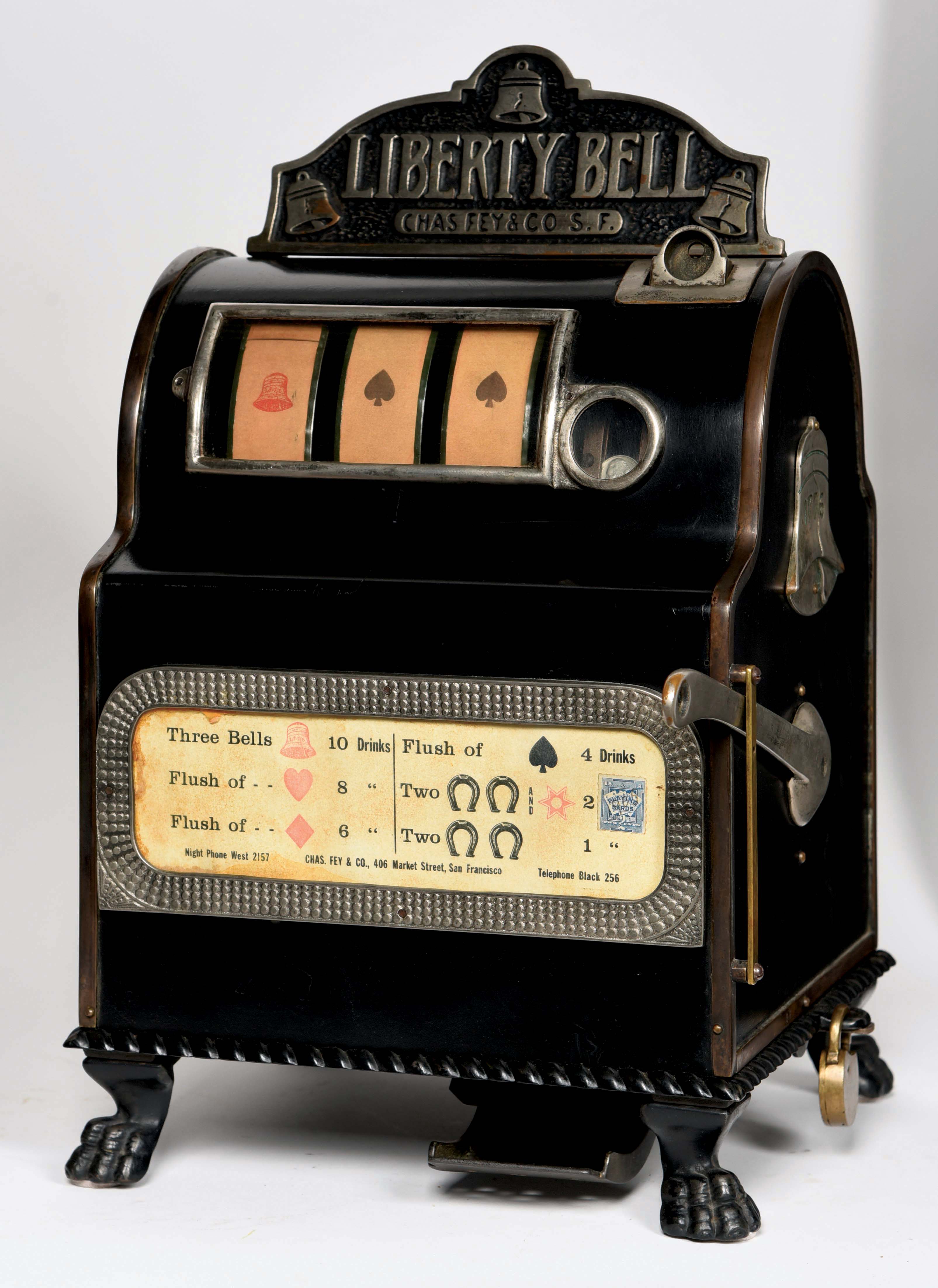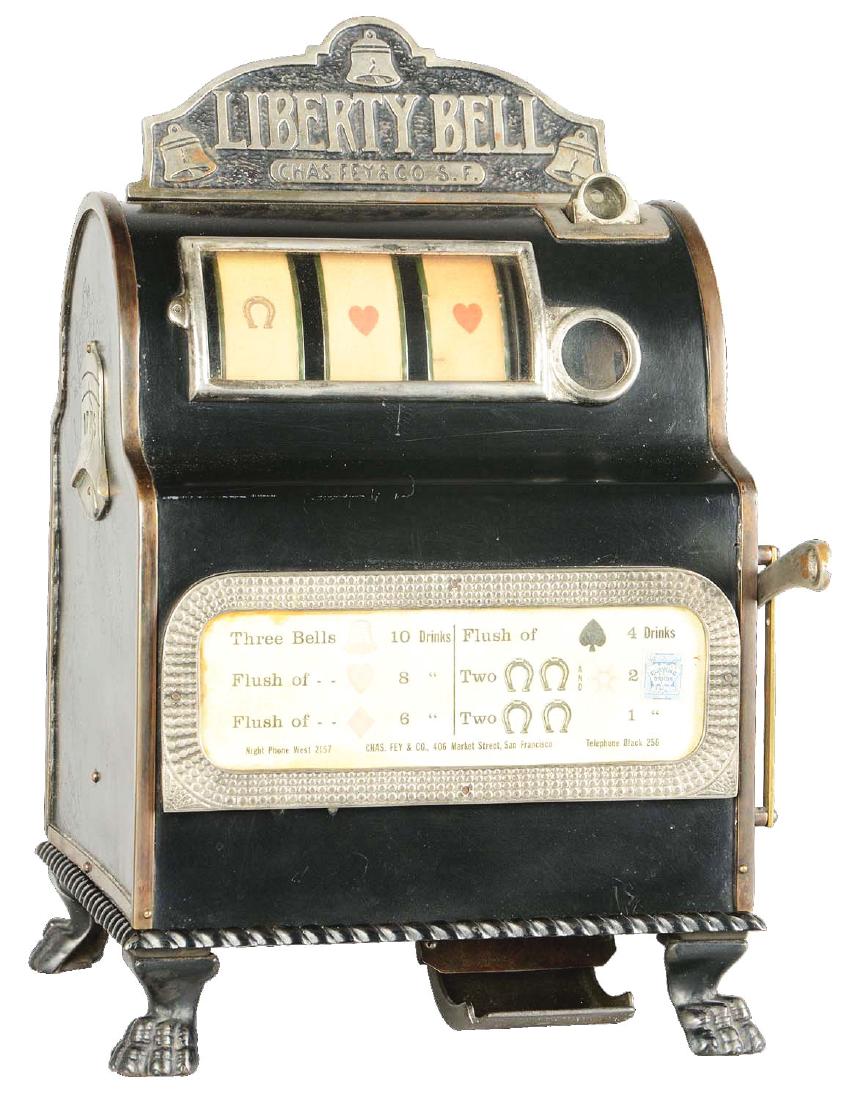Liberty Bell Slot Machine
- Liberty Bell Slot Machine Pictures
- Mills Liberty Bell Slot Machine
- Liberty Belle Saloon Reno Nevada
- 1800s Slot Machine

In this online slot machine, you will find the high-valued symbols such as the single, double and triple bar, the star, the seven, the golden bell and the game logo, which is the wild and the highest valued symbol of the game that can pay you up to 10,000 coins. The common symbols like cherries, melons, lemons, bars, and bells trigger the associations with real slot machines somewhere in a casino of Las Vegas. And the sounds taken from real casino machines strengthen these associations. If you like Liberty Bell free slot, play it online at SlotsUp.com for free!
The Liberty Bell was the first variation of the modern mechanical slot machine we see today, originally being referred to as a 'fruit machine' or 'one-armed bandit'. Created in 1894 by Charles Fey (1862–1944), a car mechanic from San Francisco, the Liberty Bell's popularity set the standard for the modern slot machine; its three-reel model is still used today despite great advances in slot technology over the past several decades. An original Liberty Bell slot machine is currently on display at the Liberty Belle saloon in Reno, Nevada as a historic artifact.[1]
How it worked[edit]
Each of Liberty Bell's three reels were imprinted with a symbol of a diamond, heart, spade, horseshoe, star and a cracked Liberty Bell. Once the player deposited a nickel, he could pull the lever on the side of the machine and the reels would begin to spin, stopping on any random combination of symbols. If the same symbol appeared on all three reels a bell would ring and the player would be awarded with coins. Three Liberty Bells offered the largest payout of fifty cents (10 nickels), which was ejected by the machine.[1]
Payouts[edit]
The payouts for the Liberty Bell were as follows:
- 2 horseshoes = 5 cents
- 2 horseshoe + 1 star = 10 cents
- 3 spades = 20 cents
- 3 diamonds = 30 cents
- 3 hearts = 40 cents
- 3 Liberty Bells = 50 cents
Popularity[edit]
In 1907, with the growing popularity and demand for the Liberty Bell, the Mills Novelty Company began manufacturing the 'Mills Liberty Bell'.[2]
In 1910 the company introduced a slight variation of the Liberty Bell, called the Operator Bell. Changes such as a gooseneck coin acceptor and fruit symbols to replace the traditional images became a standard for slot machines for decades to come, and over 30,000 of these machines were produced. In 1915 the company then began manufacturing a less expensive version of the Operator Bell, replacing the heavy cast iron machines with ones made out of lighter wooden cabinets.[2]
In the early 1930s the Mills Novelty company made additional changes to their line of slot machines. First, they designed it so that their machines were much more quieter, which eventually gave the machines the name 'silent bells'. Secondly, they created a line of themed wooden cabinets each with its own unique design, the first being Lion Head released in 1931.[3]
It was this time in the 1930s that slot machines saw a rise of popularity in America. In the late 1940s Bugsy Siegel added slot machines to his Flamingo Hotel in Las Vegas, initially as a way to entertain the wives and girlfriends of high rollers. Soon the revenue generated from these machines matched those of the table games.[3]
References[edit]

- ^ abInventors.about.com, The History of Slot Machines-Liberty Bell.
- ^ abSlot Machines Payout, Slot Machine History.
- ^ abSlot Tips Guide, The History of Slot Machines.
Charles Fey (born August Fey in Vöhringen, Bavaria) (September 9, 1862 [1] – November 10, 1944) was a San Franciscomechanic best known for inventing the slot machine.
Career and Invention[edit]
As a young man, Charles Fey worked in France and London before emigrating at age twenty-three to New Jersey, where his uncle lived.[2]
Charles traveled all over the USA and settled in San Francisco, California where he started working at the Western Electric Works company in 1885.[3] Later he started his own company together with Theodore Holtz and Gustav Friedrich Wilhelm Schultze: this company worked with electrical equipment and telephones.
In the 1880s, slot machines required an attendant to make a payout, usually tickets or tokens. Gustav Friedrich Wilhelm Schultze's 'Horseshoe Slot Machine' of 1893 was the first machine to include an automatic payout mechanism.[2] In 1895, Fey invented a modified version of the Horseshoe that paid out coins; this machine became incredibly popular.
Fey opened a slot machine workshop in 1896[4] or 1897.[2]
In 1898, he designed the 'Liberty Bell Slot Machine,' the most famous slot machine of its day. When three bells aligned, it paid fifty cents. Fey installed and managed his machines in saloons throughout San Francisco. Because gambling was illegal in California, Fey could not patent his device, leading to many competitors.[2]
Personal life[edit]

In San Francisco, Fey met Marie Christine Volkmar (1866-1942), but their courtship was interrupted by illness. In the early 1880s, Fey had been diagnosed with tuberculosis; in accordance with scientific knowledge at the time, he moved to a warmer climate (Mexico) for a few years, before returning to San Francisco for a series of creosote treatments, which were successful. He married Marie in 1889. The couple would have three daughters and one son.[2]
During this time, Fey changed his name from August to Charles, supposedly because he did not like the nickname 'Gus.'[2]
Liberty Bell Slot Machine Pictures
References[edit]
- ^'California Death Index'. Archived from the original on 2008-01-18. Retrieved 2008-02-11.
- ^ abcdefWohlers, Tony and Eric Schmaltz. 'Charles August Fey.' In Immigrant Entrepreneurship: German-American Business Biographies, 1720 to the Present, vol. 3, edited by Giles R. Hoyt. German Historical Institute. Last modified March 25, 2014.
- ^Charles Fey History and BiographyArchived June 8, 2008, at the Wayback Machine
- ^Charles Fey at SlotsMachinesHistory.com
Mills Liberty Bell Slot Machine

Liberty Belle Saloon Reno Nevada
External links[edit]

- Charles Fey at Find a Grave